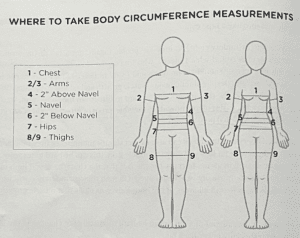Introduction To This Method
So far, we’ve looked at different methods for estimating your daily caloric needs using equations, fitness apps like MyFitnessPal and by manually estimating maintenance using bodyweight (see previous post here). Whilst these methods are generally quite accurate, they have their limitations and it’s important to remember that even the best BMR calculations provide only an educated guess. Whilst the following method is more time consuming, it provides a more reliable and individualised way of estimating your daily caloric needs.
This method involves spending 2 weeks weighing and tracking your food as best you can. You will need to record your food measurements when you prepare meals and estimate your calorie intake as accurately as possible when you are unable to prepare the food yourself during this two week period (e.g., eating out at a restaurant with your partner). You will need to own a digital body weight scale, digital food scale and an online account with a free food-tracking database like MyFitnessPal. During the 2 week period, you should aim to eat in a way that closely represents what you would normally eat on a day-to-day basis. Don’t try and change your consumption habits during this process, just eat and drink as you usually would and log everything on your food tracking app for 14 consecutive days. On top of tracking daily calories, you will also weigh yourself every morning under the same conditions discussed in my previous post (here). This involves weighing yourself completely naked first thing in the morning (taking off any devices or jewellery) before you consume any food or liquid, including water and coffee.
What If You Don’t Manage To Record 14 Days Of Data?
As this method requires significantly more time and energy than a generic calorie maintenance equation, it’s very possible that life will get in the way of you recording 14 caloric values. If this happens, and you are only able to record 4-5 weigh ins per week and 4-5 days of tracked calories, that’s not a problem, you can still use these numbers, as long as they are evenly distributed and represent your normal habits. If you are someone who indulges far more over the weekend, then only using Monday to Friday values for this method will impact the reliability and accuracy of your results.
Methodology
Assuming everything went according to plan, at the end of 2 weeks, you should have 14 weigh ins and 14 caloric values. With these numbers in front of you, start by adding together all 14 calorie values and dividing by 14. This will give you your average calorie intake across the 2-week period. So for me, I averaged 3,772 calories over the 14 days (see workings below):
Week 1 | Week 2 |
3,640 | 3,340 |
3,365 | 3,921 |
3,703 | 4,025 |
3,606 | 4,815 |
2,100 | 4,894 |
3,772 | 3,561 |
4,749 | 3,310 |
You then split your weigh-ins into 2 weekly averages, by adding your first 7 weigh-ins together and dividing by 7. Repeat this process with your last 7 weigh-ins as seen below using my recorded data (in KG).
| Week 1 | Week 2 |
| 85.3 | 84.8 |
| 85.3 | 84.7 |
| 84.8 | 84.9 |
| 85 | 85.1 |
| 85.4 | 85.5 |
| 84.8 | 85.9 |
| 85.8 | 86.6 |
| Average = 85.2 | Average = 85.4 |
Analysing The Results
As you can see from the data, I am slowly gaining weight. The next step is now to understand what this means in relation to calories. Typically, 1 lb (0.5kg) of adipose tissue contains 3,500 calories. Hypothetically, if you gained 1 lb (0.5kg) of fat in a week, you would be, on average, consuming 500 calories more than your maintenance per day, as 7 days x 500 calories = 3,500. So, in my case, as I only gained 0.4 lbs (0.2kg), I simply multiply 3500 x 0.4 = 1,400 calories. This means that I am in a weekly surplus of 1,400 calories, and therefore on a day-to-day basis I am consuming 200 calories more than my maintenance (1,400 / 7 days = 200). Thus, since my average intake over 14 days was 3,772 calories, I know my maintenance is 3,772 – 200 = 3,572 calories.
Why Is This A More Reliable Method Than Standard Equations?
While the 3500-calorie rule isn’t perfect since not all weight gained or lost is fat, and energy expenditure changes over time, this method is still a great way to roughly estimate maintenance calories. The reason being, you are using a short-term period of 2 weeks and you haven’t manipulated your diet to result in significant changes in body weight or expenditure yet. Therefore, changes in weight are predominantly fat and water and using a 7-day average will eliminate the “noise” of water weight fluctuations. So, you can be reasonably sure that the short-term changes in body weight you observe will be well represented by the 3500-calorie rule. There is nothing inherently wrong with the conventional methods, however they lack the precision and individualised workings of this method. The more progress you make in the gym, the harder it becomes to gain muscle quickly. So as you get closer to reaching your genetic potential, you will benefit from more individualised and accurate methods that can help you achieve your goals faster.
Who Should Use This Method?
If you are new to resistance training or have recently returned from a lengthy layoff/ injury, muscle mass can rapidly change and potentially invalidate the equations. For beginners, and those returning from time off training, I’d start with roughly estimating maintenance using some basic calculations (see previous post). Once the magic of “newbie gains” has worn off and you begin to plateau, then I’d recommend trying this method. If you are already an intermediate or advanced lifter who is relatively weight stable and consistent with your workout routine, this is a great way to estimate maintenance calories with better accuracy than traditional equations. Additionally, if you are very time poor (e.g., a parent with young children) this method may not be for you. If this applies to you, then you will likely be better off estimating your daily caloric needs using some basic equations.
Comparing Results Using Different Methods
As you can see below, there can be discrepancies between the different methods and equations when estimating daily calorie requirements for maintenance.
MyFitnessPal = 3,658 calories
Harris-Benedict Online Calculator = 3,541 calories
Mifflin St Jeor Online Calculator = 3,388 calories
Manual Estimation Using Bodyweight = 3,384 calories
Tracking Weight & Food Over 2 Weeks = 3,572 calories
Whilst it’s clear to see that some of these calculation methods produce less accurate numbers than manual individualised tracking it’s still a great place to start for beginners and time poor adults who are looking for quick and easy guidance on their pursuit of weight loss.
References:
- Helms. E (2019). The Muscle & Strength Pyramid: Nutrition







